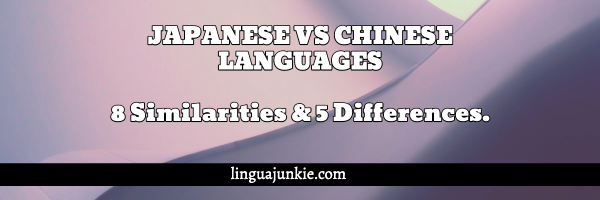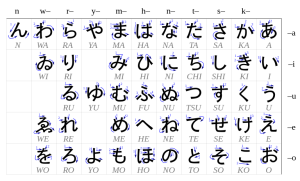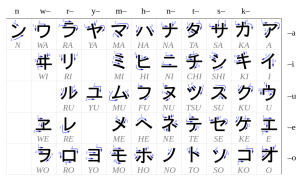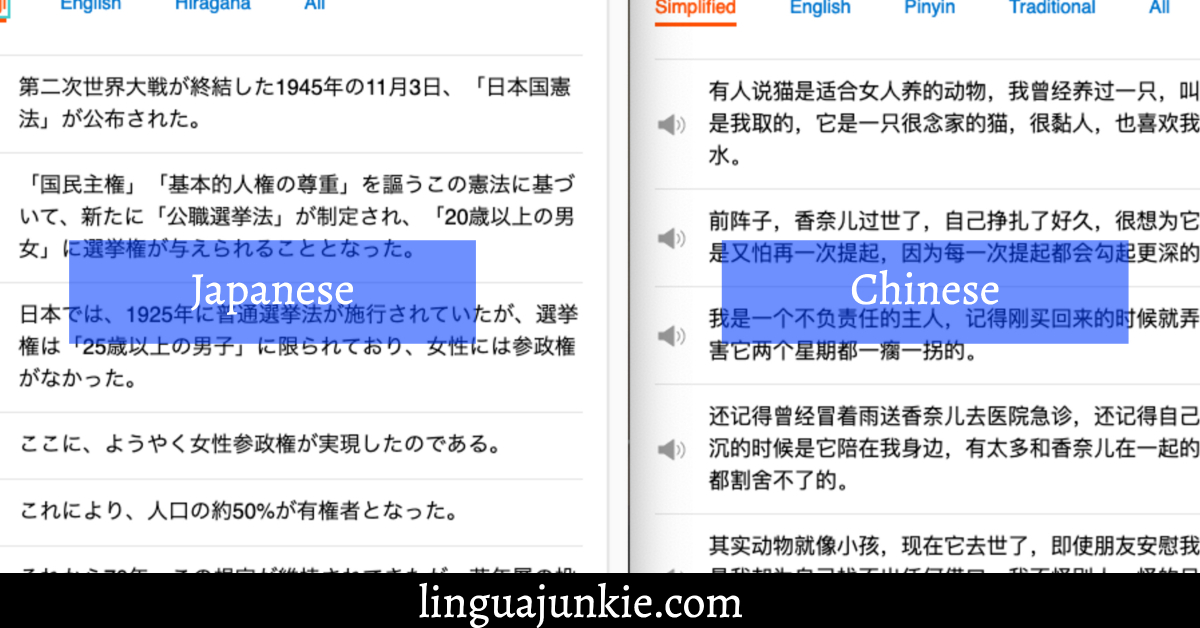How To Tell The Difference Between Japanese And Chinese Writing
So, Japanese vs Chinese language.
Some of you might be wondering…
- What's the difference between Japanese and Chinese?
- What are the similarities between Chinese and Japanese?
-
Do Chinese and Japanese speak the same language?
To answer question #3, the answer is NO. To answer the first two…
Here are the answers you've been googling for.

But first, a quick overview of Japanese vs Chinese language.
Overview of Chinese and Japanese
Chinese is one of the most spoken languages in the world, ranking in the top for the number of native speakers. It is an official language in China, Taiwan, and Singapore. The earliest traces of Chinese appeared almost 3000 years ago and is considered one of the oldest surviving languages.
- Number of speakers: 918 million (as of 2019)
- #1 most spoken language world wide.
On the other hand, the Japanese language is more recent. It was developed from the influence of China and the spread of Buddhism. It is the official language of Japan and the 8th most spoken language in the world.
- Number of speakers: 126.2 million (as of 2019)
- 8th most spoken language.
Source: https://en.wikipedia.org/wiki/List_of_languages_by_number_of_native_speakers
How Chinese and Japanese Sound.
So, how do these languages sound? Here, play these audio lessons to hear the difference.
Chinese audio lesson by ChineseClass101.com — Chinese Greetings.
Japanese audio lesson by JapanesePod101.com — Japanese Greetings.
Now, what are the differences between Japanese and Chinese language?
Take a look.
5 Differences between Japanese and Chinese Language.
- Tones
First, the tones.
In Chinese, tones are a significant part of the language and pronunciation. In Mandarin Chinese, the most widely used dialect of Chinese, there are four tones. For example, ma can be four different words depending on the tone ( mā – mother, má – hemp, mǎ – horse, mà – scold) .
In contrast, Japanese uses no tones, and is much more simplistic in its pronunciation. Syllables consist of a consonant and a vowel and each syllable is the same length.
So, Japanese sounds more monotonous than Chinese.
Now, what's the difference between Japanese and Chinese writing?
- Number of Writing Systems
Now, what's the difference between Japanese and Chinese writing?
Japanese had 3 writing systems, if you exclude romaji (the use of Latin letters like the ones you're reading now). Then, there's Hiragana and Katakana. Hiragana and Katana are essentially the same thing: 46 characters and same sounds. Katakana just looks different.
Hiragana

Katakana

Katakana is used to write borrowed foreign names and words like "Starbucks" or "McDonalds". Hiragana is used to fill in the particles necessary for grammatical structure between the kanji .
For example, here's a sample sentence:
- 私 は ベッド から 出る。
- Watashi wa beddo kara de ru.
- I get out of bed.
- The the blue characters are kanji, the orange are hiragana and the red are. So, it's a mix.
Long story short, Japanese had 3 writing systems.
- You can read about the Japanese writing systems here.
In Chinese , there is only one writing system and it is entirely written by their hanzi . However, in 1949, a new form of writing called Simplified Chinese was adopted in China. This was aimed to improve literacy and was a simple form of the traditional Chinese characters.
Now, let's take that same example sentence from above. As you can see, it's ALL Hanzi, whereas Japanese was a mix of Hiragana, Katakana and Kanji.
- I get out of bed.
- 我起床了。
- Wó qǐchuáng le.
- The blue character ares hanzi.
So, how do you tell the difference between Chinese and Japanese writing? Consider it like this…
- Japanese: 私 は ベッド から 出 る。
- Chinese: 我起床了。
- Reading Kanji vs. Hanzi
Although kanji is similar to hanzi , there is a significant difference in the number of ways the same character can be read.
In Chinese, there are at most about two ways to read a hanzi , but in Japanese it could be much more. The character for sun or day, 日, can be read as nichi , jitsu , hi , bi , or ka in Japanese.
In comparison, the same character in Chinese can only be read as rì .
- Polite Forms
Compared to Chinese, there are many forms of politeness that are incorporated into the grammar itself in Japanese. Polite forms of speech are called keigo , and there are three different forms based on formality. The polite form, the humble form, and the honorific form. While speaking Japanese, it is necessary to be conscientious of the level of politeness to fit each social situation.
- Grammar Structure
Chinese grammar structure is more straightforward than Japanese because it only uses hanzi characters. Verbs do not conjugate and only have one form in Chinese. In contrast, Japanese has many more possibilities of conjugations and particles because of the hiragana writing system. The general order of sentence structure is also different.
- In Chinese, it is similar to English and uses subject, verb, and object structure.
- In Japanese it is subject, object, then verb.
8 Similarities between Chinese and Japanese
First, you learned about the differences between the Japanese and Chinese Language.
Now, onto the similarities.
- Writing System: Kanji and Hanzi
One of the most apparent similarities between the two languages is that they share similar characters; kanji in Japanese and hanzi in Chinese.
In fact, the two languages have more than half of its characters in common. This is because Japan started by adopting China's writing system but eventually developed their own version. Over time, some of the newer kanji from Japan also came to be incorporated into Chinese.

- Numbers
In both languages, the writing for the numbers are the same. They use similar number writing structure as in English, except that there is a word for ten thousand, or 万. This means that in Japanese and Chinese, one hundred thousand would literally be written as "十(ten)万(ten-thousand)".
- Name Order
As Japan has been culturally influenced by China, the two languages also share the same concept of name order. The last name always comes before the first name when using the full name.
- Honorifics
Chinese and Japanese both place an importance on honorifics and titles, much more than in the English language. This also demonstrates the way that the Japanese and Chinese cultures value social hierarchy and status. These are usually dependent on age and familiarity. In both languages, it is less likely to refer to everyone by first name but rather their specific title. Titles could include teacher, doctor, uncle, chairman, company president, among others.
- Certain Pronunciations
Because there is a shared writing system, sometimes the characters that are used in both languages have a similar pronunciation. For example, "cheers" is pronounced kanpai in Japanese and gānbēi in Chinese.
- No Grammatical Gender
In Chinese and Japanese there is no need to change the adjectives and nouns to match in gender. Even with pronouns, until the 19th – 20th century and the influence of the west, both languages used the same word for "he" and "she".
- No Plural Forms
Most nouns in both languages lack plural forms and simply have one form. In order to know the quantity of the noun, there is usually a number or it is figured out based on context.
- Measure Words or Classifiers
A common feature of Asian languages is the use of measure words or classifiers. These are words that are used while counting to classify the object. For example, in Chinese and Japanese the word for cow is 牛, but when counting domestic farm animals there must be the measure word, 頭, before the number.
So, when it comes to Japanese vs Chinese language, you now have a good idea of…
- What the difference is between Japanese and Chinese.
- What the similarities are between Chinese and Japanese.
Also, if you want to learn Chinese or Japanese, feel free to play these audio lessons.
- Chinese audio lesson by ChineseClass101.com — Chinese Greetings.
- Japanese audio lesson by JapanesePod101.com — Japanese Greetings.
You can find more of these quick and fun audio lessons on ChineseClass101 (click here to visit) and JapanesePod101 (click here to visit).
Finally, do you know of any other language similarities and differences?
Leave a comment and I'll add it to the list.
The Main Lingua Junkie
How To Tell The Difference Between Japanese And Chinese Writing
Source: https://www.linguajunkie.com/learning/japanese-vs-chinese-language
Posted by: brightonguttend.blogspot.com

0 Response to "How To Tell The Difference Between Japanese And Chinese Writing"
Post a Comment